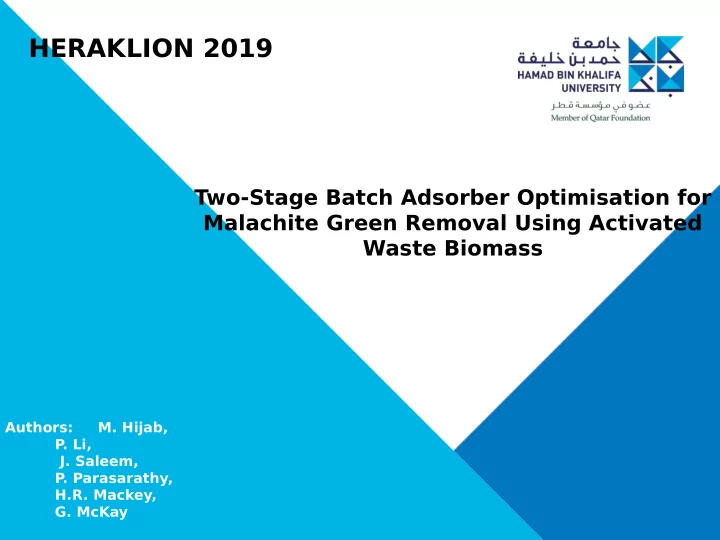

HERAKLION 2019 Two-Stage Batch Adsorber Optimisation for Malachite Green Removal Using Activated Waste Biomass Authors: M. Hijab, P . Li, J. Saleem, P . Parasarathy, H.R. Mackey, G. McKay
Outline • Introduction and Objectives • Experimental Systems • Modeling Theory and Models • Results • Conclusion 1
INTRODUCTION
Waste Biomass Sources: - Straws (wheat, rice husk…) - Shells (coconut, pistachio, palm kernel, walnut…) - Fruit stones (olive, dates, peaches, mango…) - Pine, wood, bamboo, lignin…. Source: fjltrasystems 2
Activated Carbons Source: carbon-fjlter Activation: controlled • oxidation of carbon atoms in the raw material – expanding the internal surface area Physical and chemical • activation Strong physical adsorption • and chemical reactions Low density • High porosity: pore volume • (0.2 to 0.6 cm 3 /g) Brunauer- Emmett- T eller • (BET): surface area (500 to 1500 m 2 /g) Source:yet2.com marketplace 3
Dyes (Malachite Green) • Dyes are applied to textiles, paper, leather, food, drugs, cosmetics and other products. • More than 2000 dyes are currently used (reactive orange, congo red, • Major environmental methylene blue, malachite problems (increase in COD, green) decrease in DO, toxic, carcinogenic, mutagenic, prevent light penetration Source: into water) Alibaba.c om 4
Adsorption Factors afgecting adsorption pH and Time T emperature Adsorpti on Porosity (pore size, Initial volume, and concentration distribution) Sustainabl Eco- Low cost Low energy e friendly 5
Objectives - Characterize date stones - Develop suitable activation methods - T est and compare the performance of the activated date pits adsorbents on the target pollutant of Malachite Green - Understand the adsorption mechanisms - Design a two stage adsorption system The waste product of the seedless date products industry is the date “pit” or date “stone” which is a sustainable and economical resource that can be used to enhance the treatment of water. 6
EXPERIMENTAL SYSTEMS
Experimental Systems 7
Experimental Systems (Cont.) Properties of the date stones Date stone Total volume of Mean pore BET surface pore diameter area (cm 3 /g) (nm) (m 2 /g) NDS 0.21 2.31 85.74 PADS 0.55 2.48 908.6 Adsorption Tests - Carried out at 20°C - 3g of adsorbent with MG - Shaking at 250 rpm - Measuring initial and fjnal concentrations - Mass balance (amount of dye adsorbed = amount of dye removed) 8
Two-Stage Batch Adsorber Optimisation 9
MODELING THEORY AND MODELS
Isotherms - qe :amount of contaminant adsorbed - Ce: equilibrium concentration of the contaminant Models: - Langmuir - Freundlich - SIPS Source: researchgate Errors: Model SSE, chi-square statistic, g- information: square statistic, relative - Prediction errors, absolute errors, - T ype of adsorption percentage errors, and 1 - Molecular fractional errors, etc. interaction 0
Isotherms (Cont.) Langmuir Freundlich SIPS isotherm isotherm isotherm • • adsorption capacity (mg/g): adsorption • : L-F constant constant capacity constant • : isotherm exponent • • n: constant (surface b (L/mg): energy heterogeneity) constant Assumptions: - Combination of Assumptions: Langmuir and - Ideal gas behavior Freundlich Assumptions: of adsorbate - High - Empirical equation - Molecules do not concentrations ~ - Multilayer adsorption interact among each Langmuir - Heterogeneous system other - Uniform monolayer adsorption 11
RESUL TS
Isotherm Study Parameters Isotherms PADS RDS b 0.174 0.00583 q m 64.7 29.5 Langmuir Model SSE 52.4 3.53 k F 26.7 1.22 1/n 0.165 0.476 Freundlich Model SSE 404 16.8 K LF 14.8 0.203 a LF 0.221 0.0016 SIPS Model b LF 0.840 1.34 SSE 36.2 1.30 1 2
Isotherm Study Results (Cont.) SIPS Isotherm 70 60 50 qe, mg/g 40 30 20 10 0 0 50 100 150 200 250 300 350 400 450 500 Ce, mg/L Experimental- PAADS PAADS- SIPS Experimental- NDS NDS- SIPS 1 3
NDS PADS 1 4
Single Stage vs Two Stage Adsorption Amount of PADS adsorbent required Removal % 99.50% 95% C 0 (mg/L) S (g) S1+S2 (g) S (g) S1+S2 (g) 50 11.5 2.5 2.2 1.2 100 13.5 3.5 3.1 2.1 150 15.1 4.2 3.9 2.8 200 16.4 5.0 4.7 3.6 250 17.7 5.9 5.5 4.2 300 18.8 6.4 6.2 5.0 350 19.9 7.5 7.0 5.5 400 21.0 8.3 7.7 6.2 450 22.0 9.2 8.5 7.0 500 23.0 10.0 9.2 7.5 1 5
CONCLUSION
Conclusion • Date pits are hard lignocellulosic materials with high carbon content and low impurities, and are excellent precursors for the production of activated carbons • Langmuir-Freundlich (SIPS) isotherm is the best fjt among the studied isotherms for both adsorbents and should be used for design purposes • The total amount of adsorbent increases with increasing initial concentration of malachite green dye, higher removal rate, and with an increase in the dye solution volume • The two-stage system resulted in a decrease of around 33% of the total adsorbent requirement compared to the one-stage system to remove the same amount of MG • For a commercial treatment process, the economic comparison between the adsorbent saving versus the increased cost of the two-stage adsorber over the single-stage adsorber needs to be investigated 1 6
Thank You Any Questions?
Recommend
More recommend